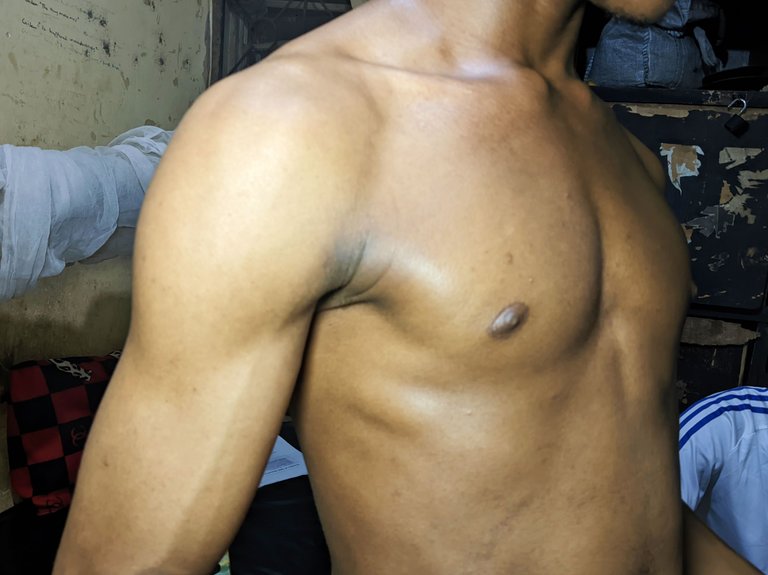Simplifying the Anatomy of the Upper limb: The Axilla

Introduction
The axilla, also known as the armpit, is a crucial area of the body that holds important structures like lymph nodes, blood vessels, and nerves. Understanding the anatomy of the axilla is essential for various medical procedures and for detecting abnormalities or diseases in this region.
In this article, we will delve into the intricate anatomy of the axilla, highlighting its significance in medical scenarios. By the end, you will have a clearer understanding of why this area is so important in the world of healthcare and how its anatomy impacts various aspects of our well-being.
Definition

The axilla, or armpit, is a vital anatomical region located beneath the shoulder joint. Known for its triangular shape, the axilla extends from the upper arm to the side of the chest. This area is bounded by various structures, including the chest wall, upper arm, and shoulder, creating a dynamic space that houses important nerves, blood vessels, lymph nodes, and muscles.
The axilla plays a role in the human body due to its rich concentration of lymph nodes, which serve as key components of the immune system. These nodes help filter and trap bacteria, viruses, and other harmful substances, preventing them from spreading throughout the body. Additionally, the axilla is a pathway for major blood vessels and nerves that supply the upper limb, making it essential for proper arm function and sensation. The anatomy of the axilla is important for healthcare professionals to accurately diagnose and treat conditions affecting this area.
Bones and Joint
In the axilla, several bones play a role in providing structure and support to the upper limb. The clavicle, commonly known as the collarbone, is a slender bone that runs horizontally across the front of the shoulders, connecting the arm to the trunk of the body. It plays a vital role in shoulder movement and helps to stabilize the shoulder joint.
The scapula, or shoulder blade, is a flat, triangular bone located on the back of the shoulder. It provides attachment points for various muscles involved in shoulder movement and helps protect the underlying structures within the axilla.
The humerus, the upper arm bone, extends from the shoulder to the elbow and articulates with the scapula to form the shoulder joint. This bone plays a key role in allowing arm movement and flexibility.
Within the axilla, there are several important joints that facilitate arm movement. The main joint in the axilla is the glenohumeral joint, where the head of the humerus articulates with the glenoid cavity of the scapula. This joint provides the greatest range of motion in the human body and is essential for activities like reaching, lifting, and throwing.
Another important joint in the axilla is the acromioclavicular joint, where the acromion process of the scapula meets the clavicle. This joint helps support the weight of the upper limb and is crucial for shoulder stability during various arm movements.
The role of these bones and joints in the axilla is essential for maintaining proper shoulder function and mobility. Issues affecting these structures can lead to pain, limited range of motion, and decreased quality of life, highlighting the significance of their anatomy in the overall well-being of an individual.
Muscles around the axilla

The axilla is home to several important muscles that play key roles in shoulder movement and stability.
Pectoralis Major: This large, fan-shaped muscle covers the chest and helps move the shoulder joint. It is responsible for actions like flexion, adduction, and medial rotation of the arm. The pectoralis major is important for various upper body exercises and everyday movements involving the arms.
Latissimus Dorsi: The latissimus dorsi is a broad muscle that extends from the lower back to the upper arm. It plays a significant role in shoulder extension, adduction, and medial rotation. This muscle is essential for activities like pulling, lifting, and climbing.
Deltoid: The deltoid is a triangular muscle located on the shoulder that helps with arm abduction, flexion, and extension. It provides strength and stability to the shoulder joint, allowing for a wide range of arm movements. The deltoid is crucial for activities that involve raising the arm overhead or out to the side.
Rotator Cuff Muscles: The rotator cuff is a group of four muscles (supraspinatus, infraspinatus, teres minor, and subscapularis) that work together to stabilize the shoulder joint. These muscles are responsible for shoulder rotation and abduction, helping to maintain proper alignment and function of the shoulder during movement. The rotator cuff muscles are essential for shoulder strength and coordination.
Serratus Anterior: This muscle is located on the side of the chest and helps stabilize the scapula against the rib cage. It plays a crucial role in maintaining proper scapular movement and shoulder function during reaching and pushing movements. The serratus anterior is important for optimal shoulder mechanics and overall arm strength.
Each of these muscles in the axilla contributes to the complex system of movement and stability in the shoulder region. By working together, they ensure proper function of the shoulder joint, allowing for a wide range of arm movements and activities. When we know the importance of these muscles, it can help us maintain shoulder health, prevent injuries, and improve overall upper body strength and mobility.
Blood Supply in the Axilla:
The axilla is supplied by the axillary artery, which is a continuation of the subclavian artery as it passes through the axilla. The axillary artery gives rise to several important branches that supply blood to the structures in the axilla and upper limb.
Branches of the axillary artery include the superior thoracic artery, thoracoacromial artery, lateral thoracic artery, and subscapular artery. These branches provide blood to the muscles, bones, and other tissues in the axilla, ensuring adequate oxygen and nutrient delivery to support proper function and movement.
The blood supply in the axilla is crucial for maintaining the health and function of the structures in the region. Adequate blood flow is essential for tissue repair, muscle contraction, and overall cellular metabolism. Issues affecting the blood supply in the axilla can lead to pain, tissue damage, and impaired movement, underscoring the importance of a well-functioning vascular system in this area.
Lymphatics in the Axilla:
The lymphatic system in the axilla plays a vital role in draining lymph fluid from the upper limb, chest wall, and breast. Lymph nodes in the axilla filter the lymph before it returns to the circulatory system, helping to remove waste products, pathogens, and other harmful substances from the tissues.
Key lymph nodes in the axilla include the central, pectoral, subscapular, and humeral nodes. These nodes play a crucial role in immune function, helping to detect and fight infections or abnormalities in the surrounding tissues.
One important clinical procedure involving the lymph nodes in the axilla is sentinel lymph node biopsy, commonly performed in breast cancer patients. This procedure helps determine whether cancer has spread to the lymph nodes, guiding treatment decisions and prognoses. Sentinel lymph node biopsy can provide valuable information about the extent of disease and help tailor treatment plans for better outcomes.
Nerves in the Axilla:
The axilla is rich in nerves that provide motor and sensory innervation to the muscles and skin of the upper limb. The brachial plexus is a network of nerves originating from the cervical and thoracic spinal cord segments that supplies the shoulder, arm, and hand.
Key nerves in the axilla include the musculocutaneous, axillary, radial, median, and ulnar nerves. These nerves control muscle movement, sensation, and coordination in the upper limb, allowing for a wide range of arm and hand functions.
The brachial plexus plays a critical role in nerve distribution in the axilla, serving as a major pathway for sensory and motor signals between the spinal cord and the upper limb. Damage to the brachial plexus or its branches can lead to loss of muscle function, altered sensation, and impaired movement in the arm and hand.
Overall, the blood supply, lymphatics, and nerves in the axilla are essential components of the upper limb's anatomy and function. The anatomy and clinical significance of these structures is important for maintaining proper shoulder health, diagnosing and treating conditions affecting the axilla, and ensuring optimal arm function and mobility.
Axillary Examination Techniques:
During a clinical examination, healthcare providers may perform various techniques to assess the axilla for signs of abnormalities or potential medical conditions. Common examination techniques include palpation of the axillary lymph nodes to check for enlargement, tenderness, or firmness, which may indicate infection or other issues. Inspection of the skin in the axilla for rashes, lesions, or abnormal pigmentation is also important in detecting dermatologic conditions.
Healthcare providers may also evaluate range of motion in the shoulder and arm to assess for musculoskeletal injuries or conditions affecting the axilla. Additionally, assessing sensation and motor function in the upper limb can help identify nerve issues or neurological conditions impacting the axilla.
Common Medical Procedures Involving the Axilla:
Several medical procedures involve the axilla for diagnostic or treatment purposes. These may include:
- Axillary lymph node biopsy: A procedure to remove and examine lymph nodes in the axilla for signs of cancer or other diseases.
- Axillary lymph node dissection: Surgical removal of multiple lymph nodes in the axilla, often performed in cases of breast cancer to assess the extent of disease spread.
- Axillary vein cannulation: Insertion of a catheter into the axillary vein for administering medications, fluids, or blood products.
- Botulinum toxin injections: Used to treat conditions like axillary hyperhidrosis (excessive sweating) by blocking nerve signals that stimulate sweat glands.
- Drain placement: After surgery, drains may be placed in the axilla to remove excess fluid and prevent complications like seromas.
Clinical Conditions Related to the Axilla:
Several medical conditions can affect the axilla, ranging from benign issues to more serious diseases. Some common clinical conditions related to the axilla include:
- Lymphadenopathy: Enlarged lymph nodes in the axilla may be a sign of infection, inflammation, or malignancy.
- Axillary hyperhidrosis: Excessive sweating in the axilla, often causing discomfort and embarrassment for affected individuals.
- Axillary abscess: Collection of pus in the axilla due to infection, requiring drainage and antibiotic treatment.
- Brachial plexus injuries: Trauma or compression of the brachial plexus may result in weakness, numbness, or pain in the shoulder and arm.
- Breast cancer: The axilla is a common site for breast cancer metastasis to lymph nodes, necessitating careful evaluation and treatment.
The examination techniques, medical procedures, and clinical conditions related to the axilla is essential for healthcare providers to provide comprehensive care, accurate diagnoses, and effective treatments for patients presenting with axillary issues. Regular clinical assessment and prompt management of axillary conditions can help improve patient outcomes and quality of life.
References
(1) The Axilla Region - Borders - Contents - TeachMeAnatomy. https://teachmeanatomy.info/upper-limb/areas/axilla/.
(2) Anatomy of the axilla: Video, Anatomy & Definition | Osmosis. https://www.osmosis.org/learn/Anatomy_of_the_axilla.
(3) Anatomy Interactive Guide: Axilla. https://anatomyvr.org/psuanatomy/aigs/msk/07_aig_axilla/index.html.
(4) Surgical anatomy of the axilla | Hellenic Journal of Surgery - Springer. https://link.springer.com/article/10.1007/s13126-012-0015-z.
(5) Anatomical variations of the axilla | SpringerPlus | Full Text. https://springerplus.springeropen.com/articles/10.1186/2193-1801-3-306.
(6) en.wikipedia.org. https://en.wikipedia.org/wiki/Axilla.


Congratulations @jsalvage! You have completed the following achievement on the Hive blockchain And have been rewarded with New badge(s)
Your next target is to reach 2000 replies.
You can view your badges on your board and compare yourself to others in the Ranking
If you no longer want to receive notifications, reply to this comment with the word
STOPCheck out our last posts:
Dear @jsalvage !
My dear young bro James!
When I look at you, you look old because you went through a lot of hard work!!😂
😂... But that's my friend Akpan, he's a boss on his own and he doesn't stress himself too much.
Now I know, you really can't tell who is who 😂😂😂
Dear James!
I misunderstood that Akpan was you. I made that mistake because I am visually impaired, so I hope you understand.😂
Dallu!
PS: I wonder how ezeemmanuel is doing!
He's doing exceedingly great. Currently, he's so busy with his last stage of education, hence he's being occupied with a lot of activities. He'll come back to hive when he clear some stuff off
James!
I miss emmanuel!
He showed me all about himself and all Nigerians.
In particular, he showed me the physical beauty of black women!😄
African women are beautiful 😄
😄 I agree with you!
Thanks for your contribution to the STEMsocial community. Feel free to join us on discord to get to know the rest of us!
Please consider delegating to the @stemsocial account (85% of the curation rewards are returned).
You may also include @stemsocial as a beneficiary of the rewards of this post to get a stronger support.